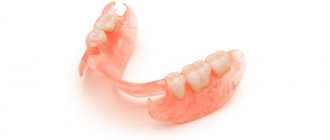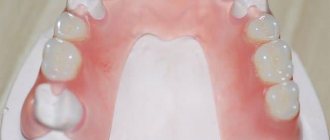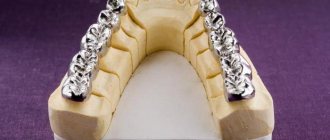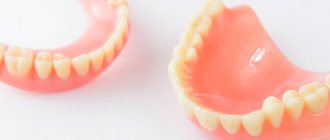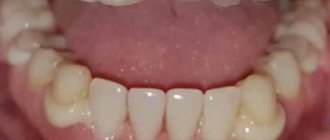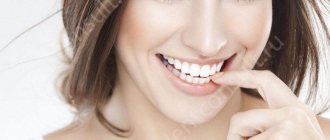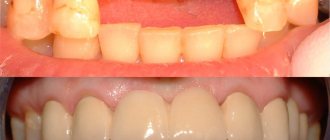Seal
Strong teeth not only provide an attractive smile, but are also the key to good health, since the health of the gastrointestinal tract and other organs of the digestive system depends on the quality of chewing food. But not every person can boast of healthy teeth. Often the integrity of the dentition is compromised due to oral diseases, injuries, age-related and other reasons.
The loss of just one tooth leads to negative consequences, including malocclusion, changes in the chewing surfaces of molars, bone tissue atrophy, etc. That is why it is recommended not to delay the installation of dentures.
Depending on individual characteristics, the orthopedic dentist offers fixed and removable prosthetics. At the same time, it is important to understand that modern removable dentures are no longer the “false jaws” that your grandfather dipped into a glass at night. Removable dentures used in dental practice are a reliable and functional design that is invisible to others and does not reduce the patient’s quality of life.
Stepanov Andrey Vasilievich - orthopedic dentist at the Dentoclass clinic.
Types of removable dentures
Removable dentures are divided into several groups according to the following characteristics:
- number of remaining teeth. According to this parameter, removable dentures are divided into complete, partial and micro dentures. As the name implies, the first two types of prosthetics are used for complete and partial loss of teeth, respectively. Microprostheses are used for the loss of one tooth;
- duration of wearing. Based on this criterion, removable dentures are divided into temporary and permanent. The first ones are recommended for restoring the dentition for the time required to make a permanent denture. Wearing such dentures prevents the displacement of adjacent teeth and provides psychological comfort. The latter is especially important if a tooth is lost in the smile area. As for permanent dentures, they are intended for long-term use;
- design and materials. Depending on the configuration of the prosthesis and the materials used, plate and clasp (with locks and clasps) prostheses are distinguished, which are made of metal, plastic, acrylic, nylon, etc.
The most widespread today are clasp and removable dentures made of thermoplastic materials, so we will consider them in more detail and outline the pros and cons for each type.
About our clinic
Dentistry “Two Dentists” is comprehensive care and high-quality treatment that meets the high standards of modern dentistry. Advanced equipment and innovative techniques will help solve any problem that causes you inconvenience - from the treatment of oral pathologies to the production of high-quality prosthetic structures indistinguishable from real teeth. Leave a request for an appointment at a time convenient for you by phone or - we will help restore and preserve the beauty of your smile!
Clasp removable denture: advantages and disadvantages
A clasp denture consists of artificial teeth, a plate base and a metal frame. The main elements of the latter are:
- a saddle-shaped part that carries a plate base with teeth attached to it;
- supporting and retaining elements - clasps, telescopic systems, etc.;
- connecting arches that provide fastening of the supporting-retaining and saddle-shaped parts of the prosthesis.
Clasp dentures are used for both partial and complete loss of teeth. In the first case, they are attached to preserved natural teeth; in the second, it is necessary to install titanium implants into the jaw bone tissue—by far the most popular.
This is what a partial clasp denture with locks looks like.
The main advantage of the clasp denture is its physiology, which ensures proper distribution of the chewing load. As for other advantages, they include:
- small area of the lamellar base;
- possibility of choosing fastening elements;
- strength and reliability;
- long service life;
- affordable price.
Now about the cons. These include the possibility of a metallic taste in the mouth. In addition, not all types of clasp dentures are suitable for installation in the visible part of the dentition; for example, when using a locking fastening, metal elements may be noticeable when speaking. However, these shortcomings are offset by the emergence of new materials and designs. Thus, the quadrotti prosthesis, although it is of the clasp type, does not have metal parts. And with the right choice of fixing elements, clasp dentures are quite aesthetic and invisible in the mouth.
When is the use of thermoplastics justified?
Thermoplastic plates are a solution for those patients whose teeth cannot be ground and there are minor defects in the dentition. Due to the unique lightness and softness of the structures, thermoplastic dentures can be used even in patients with inflammation of the periodontal tissues.
In addition, this denture material does not cause tissue irritation (which is typical for acrylic structures), and prevents the development of inflammatory processes in the oral cavity, which often occur during the use of plastic structures.
This type of prosthesis does not require special care. To ensure long service life and maintain the aesthetic appearance of prostheses, you should use products such as Corega, Ultra Sonic Wallplast or ValClean. You can also use dental floss and regular soap. Every six months you should undergo a professional cleaning procedure, which is also carried out in our One to One clinic. Waiting for you!
Removable dentures made of thermoplastic materials: advantages and disadvantages
Dentures made of thermoplastic materials (including nylon) are divided into complete and partial. They are made of soft plastic and are highly elastic. Fastening of nylon dentures is carried out both using plastic clasps and due to the pliability of the material, which seems to envelop the gums. The first method is used when installing partial and microprostheses. The second is used for complete loss of teeth.
Removable nylon dentures can be either full or partial.
The main arguments in favor of prostheses made of thermoplastic materials:
- Possibility of installation for patients prone to allergic reactions to metals;
- aesthetics - removable dentures of this type are invisible in the mouth;
- no irritation or abrasions on the gums due to soft plastic;
- elasticity of the structure, which ensures the strength and reliability of the prosthesis;
- service life - up to 5-7 years.
The main disadvantage of dentures made of soft thermoplastic materials is the incorrect distribution of load when chewing food. In addition, in some cases, special glue or gel is required to securely fix the structure.
Installation of a structure in the absence of teeth
Patients often turn to dentists asking for nylon jaws to be made in cases of complete edentia. This cannot be said about the impossibility of installing such a system. But the client must understand that implementing such a design will require a lot of time, as well as money, because implants will have to be implanted to secure it.
Softness is an excellent quality for performing the basis of a system, but this only applies to partial replacement of a row. With complete edentia, discomfort from the flexible structure will begin to appear immediately when talking and chewing food.
If bridges made of plastic take on 50% of the load, then a nylon dental prosthesis redirects it to the gums. As a result, bleeding wounds form on them.
The bridge is usually attached to the teeth. In their absence, the structure is fixed with glue, which leads to patient discomfort. There is a concern that it could fall out at any time. The increased load on the jaw bones provokes their subsidence - their height decreases by one mm every year. As a result, it becomes unusable and will need to be replaced.
Therefore, dentists, in cases of complete edentia, recommend rigid structures.
Adaptation period and service life
The average duration of getting used to prostheses is 30 days. During this time, the patient learns to eat, talk and smile with new teeth.
However, sometimes the adaptation period can increase to 3 months. This may be due to the following factors:
- atrophy of the alveolar ridge of the jaw (if the patient spent a long time without teeth and their analogues);
- poor stability of the structure (may occur due to smoothing of the gum relief or due to a poorly manufactured prosthesis);
- individual characteristics of the patient’s dental system.
This is interesting: Why do gums bleed under the crown: causes, treatment?
In order to quickly get used to the removable structure, you need to wear it all day. Removing the prosthesis from the oral cavity increases the adaptation time. In addition, the patient should immediately accustom himself to performing all necessary hygienic procedures associated with the operation of the structure in order to avoid discomfort and inflammation.
In the first days of wearing a prosthesis, increased salivation and vomiting may occur. These factors are eliminated on their own, with the body becoming accustomed to the presence of a foreign object in the oral cavity.
When you start wearing a prosthesis, you should gradually increase the load on the masticatory apparatus - chew cut pieces of fruit, bread, and other foods. You should not give up solid food. At first, you should only avoid seeds, nuts and sticky foods (taffy, caramel, etc.).
Setting up the correct articulation also happens quite quickly. If the prosthesis is well fixed, the patient quickly begins to articulate at a normal pace.
To speed up the process, you should practice speaking out loud more and actively use your facial muscles.
Competent care
Despite the high level of hygiene of nylon dentures, they require regular care, just like “living” teeth. After each meal, the denture must be rinsed with running water.
If the patient does not have the opportunity to do this immediately after eating, he should first rinse the mouth thoroughly with water , and then, when possible, remove the denture and rinse it.
To avoid damage when washing the prosthesis, you should perform the procedure over a sink filled with water or a towel folded in several layers.
This is especially true for nylon dentures, which additionally have acrylic elements installed - they can be damaged if they fall on a sink.
In the morning and evening, the denture should be cleaned in the same way as regular teeth, using a specially formulated toothpaste (without abrasive elements) and a soft-bristled brush. Specific tools for care are selected individually, together with the dentist.
At night, the structure is placed in a container with a special cleaning solution, or in an ultrasonic bath. This is necessary for better cleaning of the prosthesis and high-quality service throughout its entire service life.
At least once every six months, the denture should be submitted to a dental laboratory for professional cleaning. There, highly specialized cleaning of microdamages that cannot be eliminated on your own, polishing of the surface and elimination of microdamages takes place.
During these routine cleanings, the patient's gums are also examined and, if necessary, the denture is adjusted. Because Nylon is a plastic material; it can be deformed during wear, so such a procedure is necessary.
How to properly care for soft dentures
Maintaining oral hygiene and proper care of the structure will determine its integrity, color retention, and lack of deformation.
Here are some rules that must be followed when caring for nylon systems:
- After each meal, we recommend removing the bridge and rinsing it with warm boiled water. In hot water it becomes deformed;
- they treat it with a special brush and a special paste that will not damage its structure;
- to combat bactericidal plaque, the system should be immersed in a special solution recommended by the dentist;
- every six months the product is sent to a laboratory where cleaning is carried out;
- The cost of manufacturing nylon tooth substitutes is five times higher than plastic ones and 1.5 times higher than clasp ones.
Flexible bridges are a worthy replacement for the classic versions made of metal and plastic, especially for allergy sufferers. But they cannot withstand serious chewing loads.
Typically, the warranty period for manufactured nylon removable dentures is 12 months. But most clinics provide a guarantee for two to three years, subject to full compliance with the rules for using bridges, as well as regular visits to the dental clinic. It is known from practice that careful use and careful maintenance of the system extend its service life.
In order for removable nylon dentures to last a long time, you must:
- Do not use bleaching products.
- Protect from falling, teeth may be damaged. So, nylon partial bridges are removable, but most dentists advise not to remove them at all. If the patient cannot accept this, then they should be stored in a humid environment.
Considering the listed disadvantages, as well as positive qualities, removable dentures made of nylon are considered by practitioners and science as a temporary measure. Long-term use is acceptable if 1-2 butterfly units are replaced. But still, nylon is not yet a worthy replacement for the classics. We are talking about clasp and acrylic prosthetics.
The current high price of a nylon product can only be justified by advertising by manufacturers and its relative novelty in Russia. The contradiction of the nylon system is that its distinctive qualities - flexibility and elasticity - are simply unsuitable for long-term use.
Professional dental care and treatment in Moscow - including calling a dentist to your home, pediatric dentistry, providing assistance to people with disabilities.
Healthy and beautiful teeth are everyone’s dream. The Alexandria Dental Center will help make this dream come true.
Sources:
- https://www.vash-dentist.ru/protezirovanie/semnyie-p/neylonovyie/unikalnyie-svoystva-vertex.html
- https://superdentos.ru/cat/protesirovanie_zubov/protezirovanie_zubov_sjemnoe/termoplastichnye_zubnye_protezy
- https://dentoclass.ru/stati/semnye-protezy-vidy-osobennosti-preimushhestva/
- https://zubovv.ru/protezirovanie/semnyie-p/iz-materiala-vertex-komfort.html
- https://asteralab.ru/services/termoplasticheskie-semnye-protezy/
- https://alexandriadent.ru/ortopediya/nejlonovye-protezy/
Possible breakdowns
Damage to the integrity of Vertex products is quite rare, however, dentists identify the following situations in which product repair may be required:
- chipping or loss of an artificial tooth is eliminated in a dental laboratory by installing a new element of the row;
- if the product adheres poorly to soft tissues, adjustment of the base may be required;
- Elimination of a broken lock is carried out by replacing it with a new one;
- When cracks or breaks in the base appear, it is repaired or a new structure is made.
Dentists pay attention that repairs should only be carried out by specialized specialists. Independent actions can cause even more damage to the structure.
